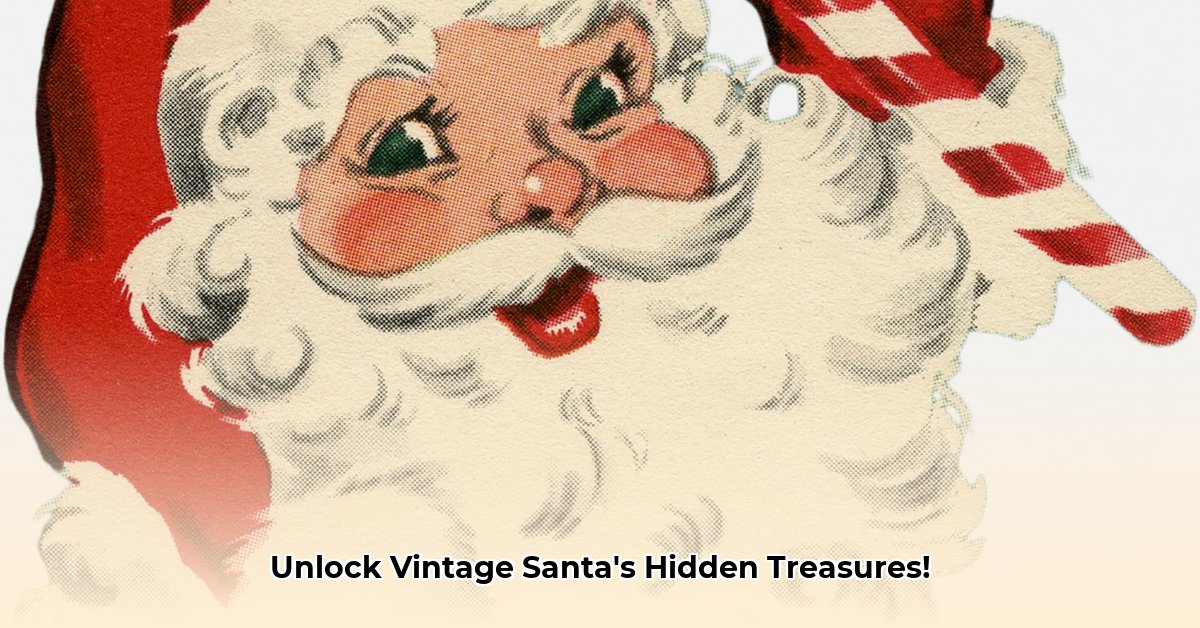Ever stumble across an old Santa Claus figurine and wonder about its story? It’s more than just a cute decoration; it could be a valuable collectible! This guide unlocks the secrets of vintage Santa collecting, whether you’re a seasoned pro or just starting out. We’ll explore the history behind these charming figures, showing you how to spot a valuable one—from the materials they’re made of to who made it and when. We’ll cover everything from how to build your own collection to understanding the market and even making smart investments. For more Santa figurines, check out this website. Get ready to dive into the fun and fascinating world of vintage Santas!
Santa Vintage: Unlocking the Secrets of a Beloved Icon
A Jolly History: Tracing Santa’s Ever-Evolving Image
The jolly Santa Claus we know and love today didn’t magically appear overnight. His image is a fascinating blend of ancient myths, religious figures, and modern marketing magic. Think back to Odin, the generous Norse god, or St. Nicholas, the kind bishop – these legendary figures, with their traditions of gift-giving and generosity, laid the foundation for our modern Santa. But the Santa we recognize now is the result of centuries of evolution, reflecting shifting cultural values and technological advancements. This remarkable transformation is beautifully mirrored in the amazing variety of vintage Santa collectibles. Ever stopped to consider the stories those antique figurines are whispering? Let’s dive into their history!
From ancient Norse myths of Odin, the generous god who flew through the sky on his eight-legged horse Sleipnir, bringing gifts, to the generous Saint Nicholas, a 4th-century bishop known for his secret gift-giving, the roots of Santa’s legend are rich and varied. Each culture added its own unique twist, creating a global character who embodies the spirit of generosity and celebration. These early influences subtly shaped how Santa Claus appeared in art and literature for centuries. The development wasn’t linear; it was a fascinating blend of tradition and reinterpretation.
Then came the impact of Washington Irving, Clement Clarke Moore, and later, the Coca-Cola company. Washington Irving’s delightful stories imbued Santa with a mischievous and whimsical side, further shaping the popular image. Clement Clarke Moore’s poem, “A Visit from St. Nicholas,” cemented the image of a jolly, round-bellied, sleigh-riding Santa, making him more universally recognizable and endearing. Coca-Cola’s iconic advertising campaign in the 1930s solidified Santa’s modern appearance – plump, rosy-cheeked, and sporting a bright red suit. We see the influence of these moments reflected in the variations found in vintage Santa collectibles. Some Santas reflect older traditions, others show the evolution towards the modern version of the icon. This is what makes finding and collecting vintage Santas so fascinating. It’s like piecing together a very merry historical puzzle. Other influences include the depictions of Father Christmas in Victorian England, who was often shown wearing a green cloak, and the German Belsnickel, a fur-clad gift-bringer who predates the modern Santa and adds another layer to the evolving legend.
Identifying the Prize: Spotting a Truly Valuable Vintage Santa
So, how does one identify a seriously valuable vintage Santa? Think of yourself as a seasoned art detective! Several clues help determine the worth of these delightful figurines; what are the key features?
- The Material Matters: Early Santas were frequently made from papier-mâché, a delicate material whose fragility actually increases their value. Ceramic Santas, especially those with elaborate details, are also in high demand. Celluloid, a very early plastic, was also used and items made from this are highly flammable, so examples in good condition are prized. The materials used immediately tell you something about the era your vintage Santa was created in. For instance, a Santa crafted from a particular type of ceramic might tell you it was made in a specific factory, at a specific time.
- The Maker’s Mark: The name behind the Santa significantly impacts its worth. Legendary manufacturers like Rushton, NAPCO, and Lefton produced iconic Santas, each with a unique style. German manufacturers like Dressel, Kister & Co. are also highly sought after. Identifying the maker is like finding a hidden treasure map! Researching these makers provides a wealth of information about the history of Santa Claus figurines. Look for backstamps, stickers, or incised marks.
- The Era is Key: Santas made before the 1930s Coca-Cola advertising campaign often command higher prices. Coca-Cola’s iconic portrayal revolutionized Santa’s image, making pre-Coca-Cola Santas particularly rare and special. Also highly collectible are Santa figures from the Victorian era, with their unique folk-art charm, and those produced during the World War II years, reflecting the wartime aesthetic.
- Condition Counts: An immaculate vintage Santa is truly a treasure. While minor imperfections can add character, significant damage diminishes the value. How well it has survived the years greatly impacts its worth. Check for cracks, chips, fading, or repairs. Original paint and details are especially valuable.
- Regional Differences: Some vintage Santas display regional customs and traditions which are highly prized by collectors who focus on specific local traditions. These local variations can be especially valuable to specialized collectors. For example, Santas incorporating elements of other cultural interpretations of the Christmas spirit, such as those featuring Krampus, or the Pennsylvania Dutch Belsnickel, are highly sought after. These unique details offer a fascinating look at cultural diversity.
- Rarity and Artistic Skill: Unique designs, limited editions, and exceptional craftsmanship significantly impact a Santa’s value. Pieces created by known artists or folk artisans tend to command higher prices. Look for unusual details like hand-painted features, intricate costuming, or unusual poses. These stand-out pieces often demonstrate an impressive artistic heritage.
- Original Packaging/Tags: If a vintage Santa comes with its original box, tags, or paperwork, it significantly increases its value. These items provide provenance and authenticity.
Building Your Collection: A Guide for Aspiring Collectors
Collecting vintage Santas is a joyful adventure! Here’s how to start; what are the key steps?
- Start Small, Dream Big: Begin with a few pieces you love, gradually building your knowledge and collection.
- Research is Your Friend: Learn to identify makers, materials, and eras. Online forums and collector communities are amazing resources. Visit antique stores, flea markets, and estate sales to see pieces in person.
- Authenticity is Paramount: Always verify authenticity before buying, especially if you’re spending a significant sum. Consult with experienced collectors or appraisers if you are unsure. Look for signs of reproduction, such as poor quality materials or sloppy workmanship.
- Handle with Care: Proper storage and careful handling preserve your collection’s value and prevents damage. Knowing the specific materials of your vintage Santa and how to care for them is essential. For example, papier-mâché figures should be stored in a dry place away from direct sunlight.
- Embrace the Community: Connect with fellow collectors. Sharing knowledge, finding rare pieces, and celebrating your passion together makes the hobby infinitely richer. Attend collector shows, join online groups, and participate in discussions.
Navigating the Market: Trends and Investment Potential
The vintage Santa market is thriving, with values influenced by the factors we’ve discussed. High-quality, rare Santas tend to produce great returns, while more common figures retain a solid market value. It’s a dynamic market, so ongoing research is always recommended. Prices can fluctuate based on trends and overall collector interest. Keep an eye on auction results, online sales, and dealer listings to stay informed. Certain styles of Santas become more popular over time, so remaining current with the trends is important. Pieces in excellent condition always command the highest prices at auction.
A Final Thought: Embark on Your Own Vintage Santa Adventure!
The world of vintage Santa collecting combines history, art, and investment potential. It’s a rewarding journey that blends the joy of discovery with the pride of building a cherished collection. It’s a chance to delve into the ever-evolving image of a beloved Christmas icon. So, go on and uncover your own hidden treasures – your own unique piece of Christmas history! Who knows what amazing Santas you might find along the way? Remember to enjoy the process of discovery, and always prioritize pieces that bring you joy.
How to identify rare vintage Santa Claus collectibles and determine their value
Key Takeaways:
- Condition, rarity, and maker’s mark are crucial for determining a vintage Santa’s value.
- Limited-edition and artist-signed pieces command premium prices.
- Understanding the historical evolution of Santa Claus imagery impacts value.
- Materials (papier-mâché, celluloid, ceramic, wood) and their fragility influence value.
- Counterfeit items exist; careful inspection and authentication are necessary.
- The market shows a distinction between mass-produced and handcrafted figurines.
- Provenance, including original packaging or documentation, can significantly increase value.
A Journey Through Time: The Evolution of Santa
Ever wondered how Santa Claus evolved from a stern, bishop-like figure to the jolly, red-suited icon we know today? His visual transformation is a fascinating story reflected in collectible figurines. Early depictions, often rooted in the legend of St. Nicholas, present a more austere image, reflecting religious traditions. Later, influences from Washington Irving and ultimately, Coca-Cola’s iconic advertising, shaped the modern Santa, a shift clearly visible in older collectibles. Even earlier depictions of Father Christmas
- Glass Tile Shower Ideas to Create a Stunning Bathroom Space - December 7, 2025
- Glass Wall Tile Ideas for Kitchens and Bathrooms - December 6, 2025
- Glass Tile Bathroom: Create a Beautiful, Easy-Clean Space - December 5, 2025










